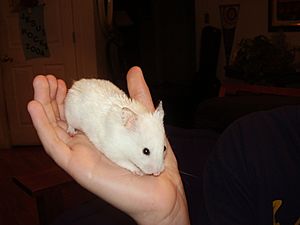Wet-tail facts for kids
Wet-tail is a serious sickness that mostly affects pet hamsters, but it can also happen to other small animals like rabbits, gerbils, rats, and mice. It's caused by a type of bacteria and often happens when an animal is feeling stressed. Even with medicine, an animal can get very sick quickly, sometimes within a day or two. Young hamsters, especially around four weeks old when they are being weaned (separated from their mothers), are more likely to get Wet-tail than older ones.
What Causes Wet-tail?
Wet-tail is caused by a specific type of bacteria called Lawsonia intracellularis that affects the animal's intestines. This sickness is often linked to stress. When a hamster is stressed, its body might not be as good at fighting off germs, making it easier for the bacteria to cause problems.
Things that can stress a hamster and lead to Wet-tail include:
- Too much handling or being picked up often
- Changes in its home or environment
- A sudden change in what it eats
- Not cleaning its cage often enough
- Being separated from its mother or siblings
- The death of another hamster it lived with
Signs of Wet-tail
It can take a few days for the signs of Wet-tail to show up. The most obvious sign is that the animal's tail looks wet and messy because of diarrhoea.
Other signs that a hamster might have Wet-tail are:
- A bad smell coming from the animal
- Loose or watery poop
- Feeling very tired or having low energy
- Not wanting to eat
- Sleeping much more than usual
- Walking with its back hunched over
How to Treat Wet-tail
If you think your pet has Wet-tail, it's important to act fast. You can buy special medicines for Wet-tail at pet shops. A vet (animal doctor) might also give your pet other medicines that are stronger.
It's very important to keep a sick animal in a separate cage by itself. This helps stop other pets from catching the disease, as Wet-tail can spread easily.
Images for kids



